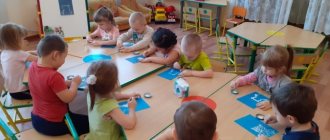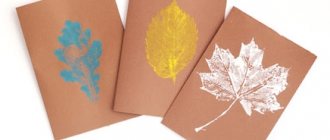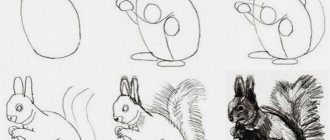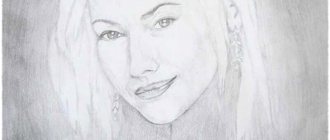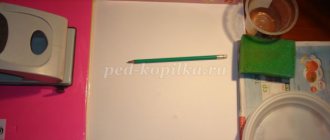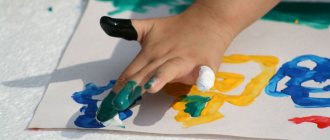Drawing lesson “Flowers for Mommy”
- January 24, 2013
Competition “My Pedagogical Initiative - 2012”
Nomination “Methodological work in preschool educational institutions”
Group: second youngest.
Educational field: "Artistic creativity."
GCD type: combined.
Goal: to familiarize children with non-traditional drawing techniques (tamponing).
Tasks:
1. Educational:
- Fine: learn to convey the image of a flower, structure and shape using non-traditional drawing techniques - printing with a paper ball and finger painting.
- Technical: master the technique of performing work using the padding method and finger painting.
- Compositional: improve compositional skills in arranging an object in the center of the sheet.
- Color: teach to use color as an artistic means of expression; consolidate knowledge of yellow and green colors.
2. Developmental: develop creative imagination, memory, speech, small muscles of the hands.
3. Educational: to cultivate neatness, aesthetic taste, to cultivate interest in actions with paper, paint, love and care for the closest person - mother, the ability to complete a task;
Didactic tools:
- Demonstration: a picture of a flower.
- Handouts: sheets of paper for drawing, sheets of paper for making balls, plates with yellow and green gouache, tray, napkins.
Connection of GCD with other educational areas: “Cognition”, “Communication”.
1. Organizational moment.
Guys, please come to me. Let's play. Finger gymnastics:
Our hands are like flowers, Our fingers are like petals. The sun wakes up - the flowers open. In the dark they will sleep very soundly again.
2. Motivational- target stage.
A wonderful time of year is coming - spring. Nature is waking up from a long sleep: the sun is shining warmer, the snow is melting, the first flowers are appearing in thawed patches! (Show a picture of a flower).
The spring holiday of mothers is coming soon - March 8th. Do your mothers love flowers? Let's give your mothers a gift, draw flowers.
3. Perception of the subject.
Look what a beautiful flower. What colour is he? Here is the leg on which it stands. What is it called? What colour is he? What's on the stem? What color are they?
4. Explanation of work methods.
4.1. A detailed demonstration of how to do it: we will draw a flower with a paper ball, for this I will take a sheet of paper, crumple it and roll it between my palms. It turned out to be a ball. I dip the ball in yellow paint and apply it to the top of the sheet, putting the ball into the tray. The result was a yellow flower. Then I dip my finger in green paint and draw a long straight line from top to bottom of the flower. The result is a stem. Again I dip my finger in green paint and draw short lines upward from the side of the stem. These are leaves. I wipe my finger with a napkin. Look what a beautiful flower I made. Guys, come to me and we'll play.
4.2. Phys. minute “Flowers grow in the meadow”:
Flowers of unprecedented beauty grow in the meadow. (Stretching - arms to the sides) Flowers are reaching towards the sun. Stretch with them too. (Stretching - hands up) The wind blows sometimes, But it’s not a problem. (Waving hands) The flowers bend down and lower their petals. (Bends over) And then they get up again And still bloom.
4.3. Questions for clarification. Now take a seat at the tables. Let's repeat what will we draw first? What color will we paint the flower? What will we draw then? What color will we use to paint the stem and leaves?
5. Practical work.
5.1. Finger gymnastics.
Let's draw a beautiful flower together. First you need to prepare a ball of compressed drawing paper. Take 1 sheet of paper. We crush it with our hands and roll it between our palms.
We squeeze a sheet of paper and knead our palms. We try, we roll together, we turn it into a ball. Let's not let him get bored, We will draw for him.
Well done, you've made a paper ball.
5.2. Corrective and individual work. You can draw a flower. I monitor and help children who have difficulties. Let me remind you that we start drawing the flower at the top of the leaf.
5.3. Analysis of children's works. How great you did it. Guys, bring all your flowers to the first table. What did we draw? And for whom? Look how beautiful they turned out.
6. Summing up. Well done, you did a good job! It turned out to be a beautiful gift for mom. In the evening, when mothers come for you, give them your flower. Your moms will love it.
Making paper balls
Productive activity
Summarizing
Bibliography:
- G. I. Davydova “Non-traditional drawing techniques in kindergarten”, Moscow, “Scriptorium Publishing House 2003”, 2008
- Basic general education program of preschool education From birth to school. Ed. N. E. Veraksy, T. S. Komarova, M. A. Vasilyeva. - M.: MOSAIC-SYNTHESIS, 2010.
Author: Natalya Andreevna Terentyeva, teacher of the MKDOU “Kindergarten of a combined type No. 27” of the Asbestovsky urban district. 2 years of teaching experience.
Summary of a lesson in the junior drawing group “Spring Flowers”
SUMMARY OF DIRECT EDUCATIONAL ACTIVITIES DRAWING “SPRING FLOWERS” 2 YOUNGER GROUP
Compiled by senior teacher Modenova I.Yu. MDOU kindergarten No. 102 in Yaroslavl Head of the kindergarten Shakhova E.G.
Goal: To develop children's creative activity through music and drawing.
Objectives: - Strengthen children’s skills in visual arts. — Consolidate knowledge about flowers. — Learn to listen carefully to music, and use dance movements to convey the character of the characters being portrayed. — Cultivate accuracy in work and a friendly attitude towards peers. — Cause an emotional and aesthetic response to the topic of the lesson.
Preliminary work: examining illustrations, conversations with children on the topic “Spring,” reading poems.
Demonstration material: illustrations depicting the seasons, toys. Handouts: tinted paper, gouache in three colors, cotton swabs and sponge swabs on stands, rags, blue ribbons for each child.
Progress of the lesson Children join the group with the teacher to the music. Educator: Guys, the Magic Brush came to visit us today! Children: Hello! Educator: Look how elegant she is! This is because she paints with different colors. Can we draw? Children: Yes, we can! Educator: Then we’ll show the Magic Brush how we prepare our fingers for drawing.
Finger gymnastics: “Chicken” The chicken went out for a walk, to nibble some fresh grass, and behind her were the children - yellow chickens. Ko-ko-ko, ko-ko-ko, don’t go far! Row with your paws, look for grains! They ate a fat beetle, an earthworm, and drank a trough full of water!
Educator: Well done! And Brush brought us wonderful paintings as a gift. (Show) What season do you think is depicted in the picture? Answers from several children: Summer. Educator: Correct. What time of year is this? Children: Autumn! Educator: What time of year did the Magic Brush depict in this picture? Children: Winter! Educator: You said everything correctly, but Brush forgot that there is another season, I’ll read it, and you guess:
Nature came to life around us, Awakened from sleep. From the blue sky (spring) has come to us with the sun! Let's help Brush and draw Spring! Sunshine, grass and the first flowers! Guys, have you noticed that we don’t have any paints? Shall we ask the assistants? Guess the riddle: The yellow guys are following the corydalis. Who are these guys?
Children: Chickens! Educator: That's right, now we will play like chickens, and for this they will give us yellow paint. Children's movements to music. Educator: It turned out great, the chicken brought paint for the sun! Let's listen to another riddle:
Where will you find it? Well, of course, in the swamp! Green as grass, Says "kva-kva-kva"
Children: Frog! Educator: Let's dance for the frogs, they will give us paint for the grass!
Here is a frog on the path, jumping with its legs outstretched. Kva-kva-kva-kva-kva-kva jumps with outstretched legs. Here from the puddle to the hummock Yes, jump for the fly Kva-kva-kva-kva-kva-kva and jump for the fly There is no more hunting, Jump again into your swamp Kva-kva-kva-kva-kva-kva jump again into your own swamp
Educator: Now we have green paint. Educator: Blue ribbon stream
Straight into the river from the hill - jump!
The river carried him
And the stream disappeared...
I will ask for blue paint from the spring stream, and you will dance with me (give the children blue ribbons and dance with the ribbons to the music of “April” by P.I. Tchaikovsky) Educator: Guys, we have collected all the paints! Do our clothes have these colors? Children: Yes, there is (they name it). Educator: We sit down at our seats and begin to draw the sun, grass and snowdrops. Brush and I will take a look. Educator: Tell me, guys, what will we draw first in our drawing? Children: The sun. Educator: That's right, first in the drawing you need to draw the objects that are located at the top of the sheet, then the objects that are located in the middle and then those objects that are at the bottom of the sheet. This must be done so as not to get dirty or smudge the drawing. What paint will we use to paint the sun? Children: yellow. Educator: Correct. Please take a large swab from a sponge, pick up some paint and use the dipping method to draw the sun. (Children do the work together with the teacher. Educator: We have the sun ready, now we will paint the grass. What color of paint do we need? Children: Green. Educator: Correct. Guys, take cotton swabs, draw paint on them and from bottom to top, like the grass is growing, we draw stripes. Now we have the grass, now we need to draw the first spring flowers - snowdrops. What kind of paint will we take for this task? Children: blue. Educator: Correct. Take small swabs from a sponge, pick up paint and use the dipping method to draw snowdrops . (Children do all the work together with the teacher for the demonstration.) Teacher: "Brush, what beautiful work the work turned out to be! Sunny, bright! The guys did their best! Well done! And now we go out onto the meadow and stand in a circle! Round dance "Vesnyanka."
Title: Summary of a drawing lesson in the junior group “SPRING FLOWERS” Author: Irina Yuryevna Modenova Position: senior teacher Place of work: MDOU “Kindergarten No. 102” Location: Yaroslavl, st. Saltykova – Shchedrina, 29
Also interesting material on drawing on croup: Lesson notes for the junior group “Visiting the Sun” (in the second junior group)
Date modified: 08/09/2015
Preview:
Summary of educational activities
“Drawing using the poke method “Yellow dandelions”.”
Expand knowledge about the first spring flowers. Improve the ability to hold a brush correctly when drawing.
Draw flower heads with a hard brush without leaving a gap between the pokes, without going beyond the contours of the image
Development of eye-hand coordination, hand control.
Instill accuracy when drawing. Form an emotionally positive attitude towards the drawing process itself.
Equipment: green gouache; a brush with stiff bristles, a sheet of paper 1/2 A-4, a cloth napkin for drawing, a paper napkin, a jar of water, a stand for the brush.
Conversation about the first spring colors with children.
Educator: “Guys, the wonderful time of the year, Spring, is coming soon. All nature will wake up from a long sleep. It will become warm again, the sun will gently warm the earth, the first flowers will appear. Which flowers will bloom first? (children's answers).
Teacher: “I’ll tell you a poem about an unusual flower.” Reading the poem “Dandelion” by O. Vysotskaya.
Look how beautiful the dandelion is! (Video of a spring dandelion blooming). How is he similar to the sun?
Children: “It’s the same round and yellow.”
Educator: Hear, someone is buzzing. Who is this?
The teacher asks a riddle:
“WINGED FASHIONISTA, STRIPED DRESS!
EVEN TINY IN GROWTH, IT WILL BITE, IT WILL BE BAD!”
The teacher brings a toy bee into the group.
The little bee found out that a dandelion had blossomed in our group. The bee really wants to collect sweet nectar.
Educator: “Guys, a bee needs a lot of flowers to collect flower nectar. Where can we get them?
On the topic: methodological developments, presentations and notes
The lesson is designed for the younger group during the dandelion flowering period.
Summary of a drawing lesson (first junior group) “Buds on a branch” (finger drawing) Purpose: Educational area: Improve children’s ability to use non-traditional images.
Summary of a drawing lesson in the junior group “Cheerful Rain” (Non-traditional technique: drawing with cotton swabs).
Purpose: To introduce the method of painting with a poke with a hard semi-dry brush, working with semolina. Develop visual skills.
Summary of the GCD "Flowers for Mom."
Topic: "Chickens". Goal: To introduce children to the technique of palm typing. Learn to add details to an image using a brush. Develop the ability to empathize. Handout
Summary of a lesson on artistic and aesthetic development: drawing using non-traditional techniques “Flowers for my mommy” Goal: To develop interest in aesthetic art.
Source


